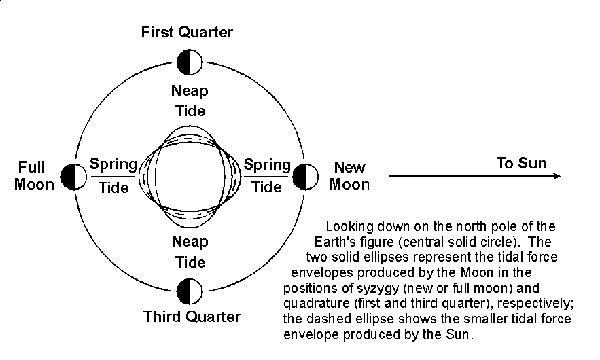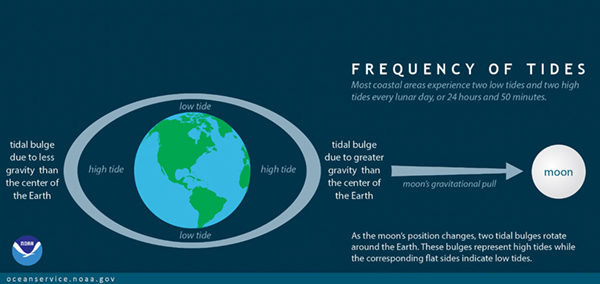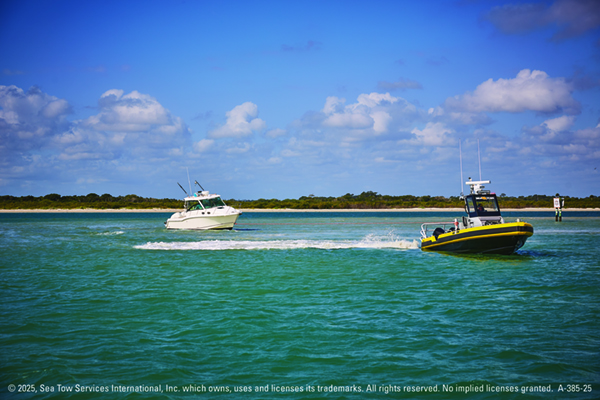Boaters who grow up fishing and cruising on inland freshwater lakes and rivers who vacation or move to coastal areas discover a new factor to consider when planning an outing: tides. They learn — sometimes the hard way — that there are places to avoid during certain tides. And this isn’t just because their boat might bump bottom at low tide but also because the increased current during a tidal event can make docking tough or make inlets treacherous to navigate.
For centuries, the nature of tides confounded some of Western civilization’s most intelligent people, like Leonardo De Vinci, who in the 13th century speculated that the breathing of a giant beast caused tides. Even Galileo got it wrong. Eventually, scientists like Johannes Kepler and Sir Isaac Newton discovered that the moon had the most significant influence on the tides. But that’s only part of the equation of this complex event.
How Many Tides a Day Do We Have?
Tide charts are based on astronomical tide calculations, which only consider the position of the moon and the sun in relation to Earth. Despite the sun’s far greater mass, the moon’s proximity affects tides more. In simple terms, high tide occurs where the moon is positioned over and under the Earth, which causes the water to bulge outward because of the gravitational pull. Most coastal areas of the United States have semidiurnal tides, roughly two high and low tides daily. The lunar day is 24 hours, 50 minutes and 28 seconds long, which is why the times of the tides change every day, and on some days, there are fewer tides.
Fun Fact: Our 60 minutes per hour/60 seconds per minute time divisions and 360-degree compass are based on the Sumerian and Babylonian sexagesimal (base 60) number system, established around 3,500 B.C., mainly because 60 is divisible by 11 numbers, which makes calculating fractions easier.

Why Does the Tide’s Intensity Change?
Not all tides are created equal because around 400 astrological cycles affect a tide’s intensity. Once every 28 days, the moon reaches perigee, its closest proximity to Earth. During this time, the moon’s gravitational pull is at its strongest, which increases the intensity of the tides. Apogee is when the moon is at its farthest from Earth, and the tides are weaker then. When the moon is full or new, the sun is aligned on the same plane as the Earth and the moon, creating stronger tides. When the moon is full or new and is also in perigee, this combination of events creates spring tides (nothing to do with the season), which are higher and lower tides than usual. Seven days after a spring tide, tides are unusually weak, called neap tides. In addition, the Earth moves around the sun in an elliptical orbit that takes about a year to complete. The sun is farthest from Earth on July 2 and closest on January 2. When it’s at its closest and the moon is in perigee during a full or new moon, this produces the strongest tides of the year, called king tides. A tide’s strength is measured by its coefficient, which ranges in value from a low of 20 to a high of 120. The higher the number, the stronger the tide. A weak neap tide might have a coefficient value of 45, while an average spring tide will have a value of around 95.

How do Tides Affect Fishing?
Tides help predatory fish by bringing the forage fish to them instead of having to chase baitfish down. Predators point into the current or wait motionless in a lee, waiting for small fish to sweep toward them. The stronger the current, the more bait funnels their way. Picture Lucille Ball in the famous chocolate factory scene, and you’ll get the idea. This orientation is why anglers should cast up-current when fishing to offer a more natural presentation.
At high tide, larger fish can temporarily venture into the shallows where fodder like crabs and small baitfish attempt to hide. A good fishing technique is to locate a mud flat rapidly losing its water and stake out an area where the last streams drain off. Predators often wait in the adjacent deep water for straggler baitfish to exit the flat. Also, look for small islands where the current hits them at an angle, which helps funnel small fish along its shoreline.
Looking for an ideal time to go fishing? When stronger tide phases occur at sunrise or sunset — when fish naturally feed —anglers should circle those dates on their calendar. Websites like tides4fishing.com are free, and they identify when fishing should be at its best by superimposing fish symbols over their tide charts during the phase that’s especially conducive to fishing. Other websites like saltstrong.com, which requires a yearly subscription, use artificial intelligence that takes tide predictions and factors in myriad variables like structure and depth to identify areas that should be good places to fish at different tide phases.
Savvy anglers who venture out during extremely low tides will discover fish tend to congregate in deeper areas next to shallows. These are also great places to target when it gets cold. Another benefit is they can see with their own eyes what lies below at their favorite fishing holes, which will be valuable intel later on.

What Other Factors Influence Tides?
The wind is among the most significant contributors to a tide’s amplitude. A strong wind can push the water entirely off a flat during low tide or reduce channel depth to non-navigable levels. Conversely, an incoming wind at an unusually high tide can cause flooding. When strong winds and tides clash in places like inlets, navigation can become hazardous and should be avoided. Atmospheric pressure also affects tides. A high-pressure system has the effect of lessening tides, while low-pressure systems increase the size of tides. The sea floor also determines the tide’s size. Narrow, deep bays like the Bay of Fundy in Nova Scotia has extreme tides that measure more than 50 feet, while wide, shallow areas with limited access to the ocean, like the Indian River on the east coast of Florida, have less extreme tides.
While tides might seem like a hassle to pleasure boaters, for anglers, having knowledge of the tides and their effect on fishing is the ultimate hack.
Back to Blue Life
For centuries, the nature of tides confounded some of Western civilization’s most intelligent people, like Leonardo De Vinci, who in the 13th century speculated that the breathing of a giant beast caused tides. Even Galileo got it wrong. Eventually, scientists like Johannes Kepler and Sir Isaac Newton discovered that the moon had the most significant influence on the tides. But that’s only part of the equation of this complex event.
How Many Tides a Day Do We Have?
Tide charts are based on astronomical tide calculations, which only consider the position of the moon and the sun in relation to Earth. Despite the sun’s far greater mass, the moon’s proximity affects tides more. In simple terms, high tide occurs where the moon is positioned over and under the Earth, which causes the water to bulge outward because of the gravitational pull. Most coastal areas of the United States have semidiurnal tides, roughly two high and low tides daily. The lunar day is 24 hours, 50 minutes and 28 seconds long, which is why the times of the tides change every day, and on some days, there are fewer tides.
Fun Fact: Our 60 minutes per hour/60 seconds per minute time divisions and 360-degree compass are based on the Sumerian and Babylonian sexagesimal (base 60) number system, established around 3,500 B.C., mainly because 60 is divisible by 11 numbers, which makes calculating fractions easier.

Why Does the Tide’s Intensity Change?
Not all tides are created equal because around 400 astrological cycles affect a tide’s intensity. Once every 28 days, the moon reaches perigee, its closest proximity to Earth. During this time, the moon’s gravitational pull is at its strongest, which increases the intensity of the tides. Apogee is when the moon is at its farthest from Earth, and the tides are weaker then. When the moon is full or new, the sun is aligned on the same plane as the Earth and the moon, creating stronger tides. When the moon is full or new and is also in perigee, this combination of events creates spring tides (nothing to do with the season), which are higher and lower tides than usual. Seven days after a spring tide, tides are unusually weak, called neap tides. In addition, the Earth moves around the sun in an elliptical orbit that takes about a year to complete. The sun is farthest from Earth on July 2 and closest on January 2. When it’s at its closest and the moon is in perigee during a full or new moon, this produces the strongest tides of the year, called king tides. A tide’s strength is measured by its coefficient, which ranges in value from a low of 20 to a high of 120. The higher the number, the stronger the tide. A weak neap tide might have a coefficient value of 45, while an average spring tide will have a value of around 95.

How do Tides Affect Fishing?
Tides help predatory fish by bringing the forage fish to them instead of having to chase baitfish down. Predators point into the current or wait motionless in a lee, waiting for small fish to sweep toward them. The stronger the current, the more bait funnels their way. Picture Lucille Ball in the famous chocolate factory scene, and you’ll get the idea. This orientation is why anglers should cast up-current when fishing to offer a more natural presentation.
At high tide, larger fish can temporarily venture into the shallows where fodder like crabs and small baitfish attempt to hide. A good fishing technique is to locate a mud flat rapidly losing its water and stake out an area where the last streams drain off. Predators often wait in the adjacent deep water for straggler baitfish to exit the flat. Also, look for small islands where the current hits them at an angle, which helps funnel small fish along its shoreline.
Looking for an ideal time to go fishing? When stronger tide phases occur at sunrise or sunset — when fish naturally feed —anglers should circle those dates on their calendar. Websites like tides4fishing.com are free, and they identify when fishing should be at its best by superimposing fish symbols over their tide charts during the phase that’s especially conducive to fishing. Other websites like saltstrong.com, which requires a yearly subscription, use artificial intelligence that takes tide predictions and factors in myriad variables like structure and depth to identify areas that should be good places to fish at different tide phases.
Savvy anglers who venture out during extremely low tides will discover fish tend to congregate in deeper areas next to shallows. These are also great places to target when it gets cold. Another benefit is they can see with their own eyes what lies below at their favorite fishing holes, which will be valuable intel later on.

What Other Factors Influence Tides?
The wind is among the most significant contributors to a tide’s amplitude. A strong wind can push the water entirely off a flat during low tide or reduce channel depth to non-navigable levels. Conversely, an incoming wind at an unusually high tide can cause flooding. When strong winds and tides clash in places like inlets, navigation can become hazardous and should be avoided. Atmospheric pressure also affects tides. A high-pressure system has the effect of lessening tides, while low-pressure systems increase the size of tides. The sea floor also determines the tide’s size. Narrow, deep bays like the Bay of Fundy in Nova Scotia has extreme tides that measure more than 50 feet, while wide, shallow areas with limited access to the ocean, like the Indian River on the east coast of Florida, have less extreme tides.
While tides might seem like a hassle to pleasure boaters, for anglers, having knowledge of the tides and their effect on fishing is the ultimate hack.
Back to Blue Life
